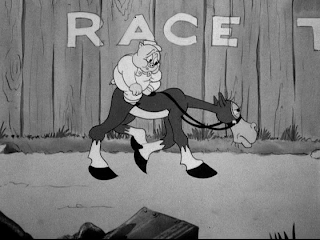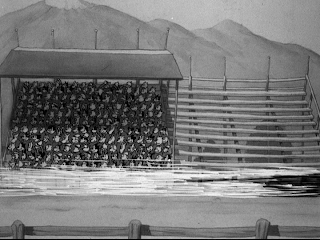shown at the Strand Theatre in New York on 9/28/36.
Other dates given are 10/3/36 or 12/28/1936 (according to IMDb, which has proven itself, ahem, a mite unreliable)
DVD/BLU-RAY AVAILABILITY:
Looney Tunes Golden Collection,
Vol. 5 (Warner Brothers DVD 112172)
You can watch a nice black-and-white print of this cartoon HERE. If you're not familiar with this cartoon, please watch before you read--thanks!
In popular entertainment, lightning always attempts to restrike. If Movie A, Song A, or TV Series A proves a success, a rehash is always urged by the highers-up. Apparently, thus was the case with Avery's earlier picture, Porky the Rainmaker. In this case, it was willingly done, and the results show a strong step forward in Avery's skillset as a cartoon film-maker.
Curiously, a completely unrelated (and more formally inventive) cartoon, The Village Smithy, separates this sequel from its forebear. It may have taken time for enthusiastic audience response to reach the Schlesinger office.
This is another early Avery effort that has been restored, and is in lovely visual and audio form on the fifth Looney Tunes Golden Collection DVD sets. In each of his early cartoons, Avery makes an obvious, conscious effort to step up the pace--to cram more into an animated cartoon than Hollywood had ever done.
Avery's goals can be seen as a refinement of the Fleischer Studios', in their pre-Hays Code peak of 1930-34. Those cartoons are stunningly crammed full of content. An 8 minute cartoon might actually contain 25 to 30 minutes' worth of material. Actions overlap, sometimes to a maddening degree, in the Fleischer cartoons of this brief but potent period. The philosophy seems to have been: throw something in, repeat, throw something else in on top of that, and one of those might get a laugh.
Avery was conscious that the content be coherently presented. Off-the-cuff (or off-the-wall) humor was keen, but it had to add to the stakes of the narrative, and its inherent comedy. A focused attempt to make a cartoon's pace faster, faster, and thus fuller of sheer consumable material drives Avery's early Warner Brothers cartoons.
Milk and Money's opening shot is very similar to its prequel's...
The camera discovers Porky's poppa tilling the soil, as though nothing's wrong. In this sense, this cartoon can be seen to take place perhaps a day, or week, after Porky the Rainmaker. Seldom do we see Schlesinger cartoons with this degree of continuity. It wasn't prudent to do much of this, since the cartoons were usually run once, for a few weeks, and then retired to the vaults for several years.
"Th-th-that's m...m...my son P...orky!" exclaims Pop, looking right in our eyes, in the event we've never seen one of these cartoons before.
Two symbiotic relationships are quickly set up: Porky's to the work-horse...
and the work-horse's to the blood-thirsty Hank the Horsefly...
we see from Hank's POV what matters most to him, and where he's immediately headed...
Yowch!
This injury-to-the-ass has beneficial tidings for the farmwork. Getting the noodge to the keester causes high-speed, high-precision plowing...
...and requires immediate topical relief to the affected area. Early on, the critical point of this story--that the horsefly's bite causes prize-winning speed from the laconic nag--is 100% established.
This ritual (Porky's chagrin included) appears to be part of the daily chores of the Pig farm.
All appears well (and, we repeat, appears)...
Uh oh... trouble's a-comin'...
Mr. Viper's full subtitle is THE SNAKE!, followed by a series of cuss-word memes that I can't replicate on this computer keyboard. Beautifully animated by Charles M. Jones in these introductory scenes, Mr. Viper is the first iteration of an Avery villain type that will recur in his later cartoons.
Viper's entrance is shown, cleverly, through the shadow of his horse-carriage, as it descends upon the fearful agrarian pigs...
Unctuous and falsely cordial, Viper is both a genre parody (one already seen in many sound-era cartoons) and a successfully distinct entity--thanks, in large part, to Jones' expressive, fluid animation. Compare these scenes to those of the medicine show hawker in Porky the Rainmaker, and you'll be stunned at the strong progress Jones made in the space of two animated cartoons.
Avery was fond enough of this snake gag to re-use it in his banned 1947 masterpiece, Uncle Tom's Cabana (in which the Simon Legree character is a post-war update of Viper's look-and-feel.)
To say nothing of the character's decade-earlier reprise in Avery's neglected, brilliant Uncle Tom's Bungalow (which will be covered here soon enough... and, yep, that's Jones' artwork too.)
Avery must have really liked this character design. The pointed ears are made even more wolf-like in the 1947 model.
These echoes (and pre-shadowings) of characters, gags and concepts run rampant through Avery's animation career. I'll hop out of this rabbit-hole and get back on track...
It's the old yada-yada--mortage is due... pay up by specific time or lose the farm. It rather ruins Poppa Pig's workday...
Avery has already broken the fourth wall twice, in the cartoon's first two minutes and 11 seconds. For variety, he fusses with the film exposure. Porky's gloomy pop mumbles, "Th-things look p-pretty dark, son... p-pretty d-dark..."
And damned if the exposure doesn't constrict, causing the film to nearly fade to black!
The more upbeat Porky fights back: "B-b-b... brighten up, pop... b-b-brighten up!" (And the film exposure does so.)
Fade in (with elegant inter-title) on Porky, who scours the want-ads section while the horse snoozes, as is his general goal in life...
In a clever (if awkward-looking) match dissolve, Porky (and we, the audience) enter the offices of the Fuller-Water Milk Co., where an executive type, with deco earmuff pattern baldness, hires pig and horse, with a stern admonition...
"If yuh break one bottle, you're fired!"
Thus. a new career in dairy delivery dawns on our porcine protagonist.
Meanwhile, back at the farm, a supply-and-demand relationship, long taken for granted, becomes sorely missed by Hank Horse-fly...
What's a parasite to do? Head for the bright lights and paved streets of the big city... and his favorite horse's as...piration!
Meanwhile, Porky is being made a fool of by a blase union of alley cats, in another Avery gag worthy of a Jacques Tati film...
Enter a little topical humor.
Porky appropriately puts a rubber glove on the lip of one bottle, so it can nurse all the quints at once. American movie-goers, in the fall of 1936, would have instantly gotten--and laughed at--this au courant gag.
Avery enjoyed this D. W. Griffith-school cross-cutting, as narrative
threads inexorably weave. Meanwhile, back on the job, Porky
runs out of milk, and finds a screwball way to replenish his stock:
He then experiences a very Fleischer moment. A potential customer, on the penthouse floor of a skyscraper, calls out for milk. Porky delivers!Since we're up so high, makes sense to check in on the horsefly. He's in the city, and has a bead on his friend/food source...
Those luscious flanks! Hank becomes erect with purpose and desire... and readies himself for the satisfaction of his needs.
But, in the world of Avery, focused intent and/or desire are often frustrated. Hank has to wait out a slow traffic light!
I never knew insects had speed gears, but Hank's prove most effective.
Contact is instant and intensely nourishing!
We're treated to another intense depiction of extreme speed, as in Avery's first Schlesinger cartoon. Porky and horse break the one rule of their employer--in spades!
Porky is, in essence, self-fired. We cut to the dejected, unemployed
pair, bitterly aware that they have failed in a moment of crisis. They
pass a race track...
Dobbin, as gluttonous as he is sluggish, spies some free food. Without
realizing it, the pair have entered themselves into a horse race!Porky's WTF expression, though poorly drawn, is priceless, as a caricatured African-American brings Dobbin into the lineup.
And... they're off!
Porky (and we) take in a vital piece of information here:
Lightnin' burns some serious horse-shoe leather, and makes up for lost laps at the speed of light.
Opportunities for a string of related sight gags? Can do! Lightnin's speed sucks three jockeys onto one horse...
causes horse and rider to change roles (to the horse's delight...)
and shifts a stadium-full of spectators from one set of bleachers to another--en masse.
Heading for the home stretch...
The track railing and the finish line sign bend with Lightnin's bite-induced speed burst.
And the horse immediately returns to its previously scheduled coma.
The winnah! And just in the nick of time...for back in farmland...
We're treated to more of that beautifully nuanced Chuck Jones animation, as Viper watches for his watch to tip from 2:59 to 3 PM...
 |
| "I've got him going!" |
 |
| "W-w-w-well, I'll b-b-be j-j-j-j-jiggered!" |
(click to enlarge)
"Curses!"
("I'm sunk!")
We learn that Hank Horsefly isn't only partial to equines!
The triumphant pigs earn the right to evict Viper from their cartoon universe. With Pop's help, Porky strains to reach the black void that is the end of the universe for Tex Avery's cartoon world:
Viper will cease to exist in a few moments... seldom has "That's All Folks!" been so grimly literal.
Milk and Money is, in every way, a major improvement on Porky the Rainmaker. The difference in sophistication, timing and confident presentation are startling. In Rainmaker, Avery experiments with new ideas. Here, he perfects them, and gets back on track with his heroic attempts to speed up Hollywood cartoons.
Avery will go from strength to strength over the next 18 months. Next, it's a return to the Technicolor world of Merrie Melodies...
Up next: Don't Look Now!


































































































































































The Strand theatre in New York was playing this cartoon on Sept. 28, 1936, according to the New York Post of that date.
ReplyDeleteArchie Winsten wrote: "It is about time to say that on the basis of recent returns the cartoon people are almost catching up to Walt Disney. Disney's latest, "Toby Tortoise Returns," is, for him, a routine effort, while this "Milk and Money" develops an excellent villain, Mr. Viper, the nasty mortgage man."
Tex is inching towards the breakthrough idea of the comic villain -- i.e., the bad guy who really isn't much of a threat at all and is played strictly for laughs, which would become the backbone of Warners' cartoons of the 1940s and 50s. He doesn't get there until 1937's "Little Red Walking Hood" but it's still interesting to watch him slowly move away from the standard Disney-type bad guy (that mandated at least some sense of drama amid the comedy), with Tex allowing Billy Bletcher to toss in a slightly comic aside from time to time in this cartoon (which is a bit of a carry over from the Mad Bomber talking to the audience during "The Blow Out")
ReplyDeleteI am really enjoying this blog! Great that you're digging up all of these links to Tex's cartoons.
ReplyDeleteThat character design is also very close to Clampett's Beany And Cecil villain Dishonest John. I guess that design was very popular throughout the unit.